Formation of Both Heme and Apoprotein Adducts Contributes to the Mechanism-Based Inactivation of Human CYP2J2 by 17 α-Ethynylestradiol
- PMID: 29602797
- PMCID: PMC5931439
- DOI: 10.1124/dmd.118.080903
Formation of Both Heme and Apoprotein Adducts Contributes to the Mechanism-Based Inactivation of Human CYP2J2 by 17 α-Ethynylestradiol
Abstract
17α-Ethynylestradiol (EE), a major component of many oral contraceptives, affects the activities of a number of the human cytochrome P450 (P450) enzymes. Here, we characterized the effect of EE on CYP2J2, a major human P450 isoform that participates in metabolism of arachidonic acid. EE inactivated the hydroxyebastine carboxylation activity of CYP2J2 in a reconstituted system. The loss of activity is time and concentration dependent and requires NADPH. The KI and kinact values for the inactivation were 3.6 μM and 0.08 minute-1, respectively. Inactivation of CYP2J2 by EE was due to formation of a heme adduct as well as an apoprotein adduct. Mass spectral analysis of CYP2J2 partially inactivated by EE showed two distinct protein masses in the deconvoluted spectrum that exhibited a mass difference of approximately 312 Da, which is equivalent to the sum of the mass of EE and one oxygen atom. Liquid chromatography-tandem mass spectrometry (LC-MS/MS) analysis revealed a heme adduct with MH+ ion at m/z 875.5, corresponding to alkylation of an iron-depleted prosthetic heme by EE plus one oxygen atom. The reactive intermediate responsible for covalently modifying both the prosthetic heme and apoprotein was characterized by trapping with glutathione (GSH). LC-MS/MS analysis revealed two GSH conjugate isomers with MH+ ions at m/z 620, which were formed by reaction between GSH and EE with the oxygen being added to either the internal or terminal carbon of the ethynyl moiety. High-pressure liquid chromatography analysis revealed that three other major metabolites were formed during EE metabolism by CYP2J2.
Copyright © 2018 by The American Society for Pharmacology and Experimental Therapeutics.
Figures

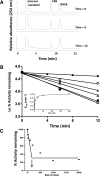
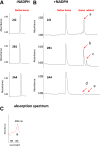
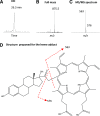
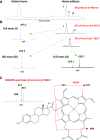
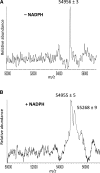
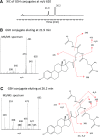
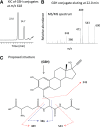
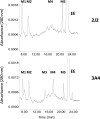
Similar articles
-
Acetylenes: cytochrome P450 oxidation and mechanism-based enzyme inactivation.Drug Metab Rev. 2019 May;51(2):162-177. doi: 10.1080/03602532.2019.1632891. Epub 2019 Jul 7. Drug Metab Rev. 2019. PMID: 31203694 Free PMC article. Review.
-
The inactivation of cytochrome P450 3A5 by 17alpha-ethynylestradiol is cytochrome b5-dependent: metabolic activation of the ethynyl moiety leads to the formation of glutathione conjugates, a heme adduct, and covalent binding to the apoprotein.J Pharmacol Exp Ther. 2007 Apr;321(1):276-87. doi: 10.1124/jpet.106.117861. Epub 2007 Jan 24. J Pharmacol Exp Ther. 2007. PMID: 17251390
-
Heme Modification Contributes to the Mechanism-Based Inactivation of Human Cytochrome P450 2J2 by Two Terminal Acetylenic Compounds.Drug Metab Dispos. 2017 Sep;45(9):990-999. doi: 10.1124/dmd.117.075846. Epub 2017 Jul 11. Drug Metab Dispos. 2017. PMID: 28698302 Free PMC article.
-
Mechanism-based inactivation of cytochrome P450 3A4 by 17 alpha-ethynylestradiol: evidence for heme destruction and covalent binding to protein.J Pharmacol Exp Ther. 2002 Apr;301(1):160-7. doi: 10.1124/jpet.301.1.160. J Pharmacol Exp Ther. 2002. PMID: 11907170
-
CYP2J2-mediated metabolism of arachidonic acid in heart: A review of its kinetics, inhibition and role in heart rhythm control.Pharmacol Ther. 2024 Jun;258:108637. doi: 10.1016/j.pharmthera.2024.108637. Epub 2024 Mar 22. Pharmacol Ther. 2024. PMID: 38521247 Review.
Cited by
-
Acetylenes: cytochrome P450 oxidation and mechanism-based enzyme inactivation.Drug Metab Rev. 2019 May;51(2):162-177. doi: 10.1080/03602532.2019.1632891. Epub 2019 Jul 7. Drug Metab Rev. 2019. PMID: 31203694 Free PMC article. Review.
-
Role of Arginine 117 in Substrate Recognition by Human Cytochrome P450 2J2.Int J Mol Sci. 2018 Jul 16;19(7):2066. doi: 10.3390/ijms19072066. Int J Mol Sci. 2018. PMID: 30012976 Free PMC article.
-
Time-dependent enzyme inactivation: Numerical analyses of in vitro data and prediction of drug-drug interactions.Pharmacol Ther. 2020 Feb;206:107449. doi: 10.1016/j.pharmthera.2019.107449. Epub 2019 Dec 11. Pharmacol Ther. 2020. PMID: 31836452 Free PMC article. Review.
-
Inhibition of Cytochrome P450 Enzymes by Drugs-Molecular Basis and Practical Applications.Biomol Ther (Seoul). 2022 Jan 1;30(1):1-18. doi: 10.4062/biomolther.2021.102. Biomol Ther (Seoul). 2022. PMID: 34475272 Free PMC article. Review.
-
CYP2J2 Molecular Recognition: A New Axis for Therapeutic Design.Pharmacol Ther. 2020 Nov;215:107601. doi: 10.1016/j.pharmthera.2020.107601. Epub 2020 Jun 11. Pharmacol Ther. 2020. PMID: 32534953 Free PMC article. Review.
References
-
- Ahluwalia BS, Curry CL, Crocker CL, Verma PS. (1977) Evidence of higher ethynylestradiol blood levels in human hypertensive oral contraceptive users. Fertil Steril 28:627–630. - PubMed
-
- Baillie TA, Davis MR. (1993) Mass spectrometry in the analysis of glutathione conjugates. Biol Mass Spectrom 22:319–325. - PubMed
-
- Bolt HM, Bolt M, Kappus H. (1977) Interaction of rifampicin treatment with pharmacokinetics and metabolism of ethinyloestradiol in man. Acta Endocrinol (Copenh) 85:189–197. - PubMed
-
- Chan WK, Sui Z, Ortiz de Montellano PR. (1993) Determinants of protein modification versus heme alkylation: inactivation of cytochrome P450 1A1 by 1-ethynylpyrene and phenylacetylene. Chem Res Toxicol 6:38–45. - PubMed
-
- Chang SY, Chen C, Yang Z, Rodrigues AD. (2009) Further assessment of 17α-ethinyl estradiol as an inhibitor of different human cytochrome P450 forms in vitro. Drug Metab Dispos 37:1667–1675. - PubMed
Publication types
MeSH terms
Substances
Grants and funding
LinkOut - more resources
Full Text Sources
Other Literature Sources

